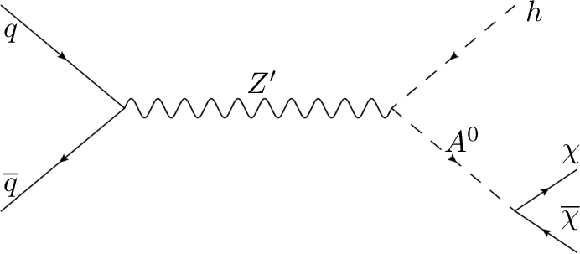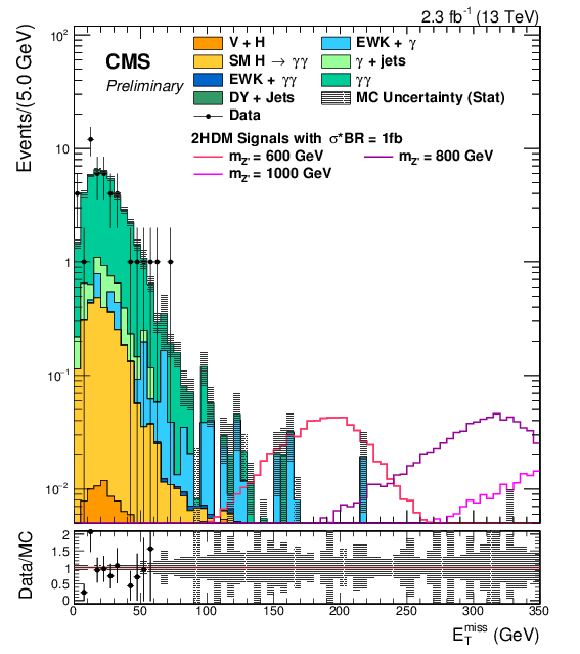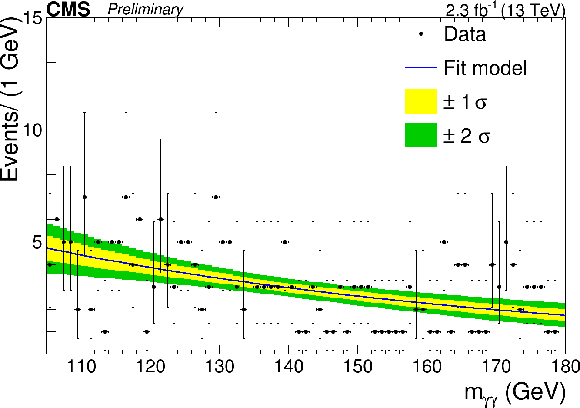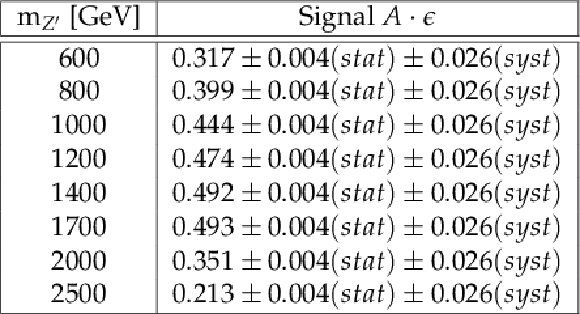

Compact Muon Solenoid
LHC, CERN
| CMS-PAS-EXO-16-011 | ||
| Search for dark matter produced in association with a Higgs boson decaying to two photons | ||
| CMS Collaboration | ||
| August 2016 | ||
| Abstract: The results of a search for dark matter produced in association with a Higgs boson where the Higgs boson decays to two photons are presented. The analysis is based on the data collected in 2015 at a center-of-mass energy of 13 TeV in proton-proton collisions with the CMS detector at the LHC. A two-Higgs-doublet model is taken as the benchmark model. After the final selection, using a dataset of 2.3 fb$^{-1}$ of integrated luminosity, no significant evidence for dark matter particle production has been observed. For the benchmark model, limits on the cross section times branching ratio for dark matter production are placed at approximately 3 fb for the Z' mass range of 600 to 2500 GeV. | ||
| Links: CDS record (PDF) ; inSPIRE record ; CADI line (restricted) ; | ||
| Figures | |

png pdf |
Figure 1:
Feynman diagram for the 2HDM DM-Higgs interaction. |

png pdf |
Figure 2:
Distribution of the diphoton invariant mass of events passing all selection criteria expect the requirement on ${E_{\mathrm {T}}^{\text {miss}}}$ applied. The signal cross section times branching fraction is set to 1 fb. The total MC background is normalized to the integral of the data. |

png pdf |
Figure 3:
Distribution of the missing transverse energy of the events passing all selection criteria including the requirement that ${m_{\gamma \gamma }}$ be within [120,130] GeV. The signal cross section times branching fraction is set to 1 fb. The total MC background is normalized to the integral of the data. |

png |
Figure 4:
Fit to the diphoton spectra in the low-$ {E_{\mathrm {T}}^{\text {miss}}}$ control region in data used to evaluate $\alpha $. The fit function used is a power-law with one free parameter. The uncertainties on the background shapes associated with the statistical uncertainties of the fit are shown by the 1 and 2$\sigma $ bands. |

png pdf |
Figure 5:
Expected and observed limits at 95% CL on the signal cross section. Also plotted is the theoretical cross section with the assumption that $g_Z =$ 0.8. Details on this model are listed in Section 3.1 and in Ref. [6]. |
| Tables | |

png pdf |
Table 1:
Maximum allowable value of each variable used in barrel and endcap photon identification [22]. The ${p_{\mathrm {T}}}$ used in these formulas is expressed in GeV. |

png pdf |
Table 2:
Signal acceptance times efficiency in the signal region. |
| Summary |
| A search for dark matter produced in association with a Higgs boson is presented. The analysis is based on 2.3 fb$^{-1}$ of pp collision collected by the CMS experiment in 2015 at $\sqrt{s} =$ 13 TeV. This analysis focuses on a 2HDM simplified model in which a DM-Higgs interaction occurs from the decay of a Z' into a pseudoscalar $\mathrm{A}^0$ and a Higgs boson. We study the case where the Higgs boson decays to two photons. After passing trigger requirements, events are selected if they contain two photon candidates passing kinematic requirements on the $p_{\mathrm{T}}/m_{\gamma\gamma}$ of the two photons, $E_{\mathrm{T}}^{\text{miss}}$ and $p_{\mathrm{T}\gamma\gamma}$ obtained with an optimization study on the benchmark model. A lepton veto is applied to reduce the electroweak background together with topological requirements to avoid events with highly energetic objects collinear with the $E_{\mathrm{T}}^{\text{miss}}$ for which the $E_{\mathrm{T}}^{\text{miss}}$ could simply arise from a misreconstruction of the jet itself. Data driven techniques are applied to estimate the non-resonant background contributions. With the optimized selection, limits on the signal cross section are calculated. The projected upper limits on the cross section are approximately 2 to 5 fb for the $m_{\mathrm{Z}'}$ range considered. Observed limits are consistent with the expectation at the one-sigma level. |
| References | ||||
| 1 | CMS Collaboration | Observation of a new boson at a mass of 125 GeV with the CMS experiment at the LHC | PLB 716 (2012) 30 | |
| 2 | ATLAS Collaboration | Observation of a new particle in the search for the Standard Model Higgs boson with the ATLAS detector at the LHC | PLB 716 (2012) 1 | |
| 3 | ATLAS Collaboration | Search for Dark Matter in Events with Missing Transverse Momentum and a Higgs Boson Decaying to Two Photons in pp Collisions at $ \sqrt{s}=8 $ TeV with the ATLAS Detector | PRL 115 (2015) 131801 | |
| 4 | ATLAS Collaboration | Search for new phenomena in events with missing transverse momentum and a Higgs boson decaying to two photons in p p collisions at $ \sqrt{s} = 13 $ TeV with the ATLAS detector | ATLAS-CONF-2016-011 | |
| 5 | L. Carpenter et al. | Mono-Higgs-boson: A new collider probe of dark matter | PRD89 (2014), no. 7, 075017 | 1312.2592 |
| 6 | A. Berlin, T. Lin, and L. Wang | Mono-Higgs detection of dark matter at the LHC | JHEP 2014 (2014) 1 | |
| 7 | The CMS collaboration | The CMS experiment at the CERN LHC | JINST 3 (2008) S08004 | |
| 8 | D. Abercrombie et al. | Dark Matter Benchmark Models for Early LHC Run-2 Searches: Report of the ATLAS/CMS Dark Matter Forum | hep-ex/1507.00966 | |
| 9 | CMS Collaboration Collaboration | Search for dark matter in association with a Higgs boson decaying into a pair of bottom quarks at sqrt(s) = 13 TeV with the CMS detector | Technical Report CMS-PAS-EXO-16-012, CERN, Geneva | |
| 10 | ATLAS Collaboration | Search for Dark Matter in association with a Higgs boson decaying to $ b $-quarks in $ pp $ collisions at $ \sqrt{s}=13 $ TeV with the ATLAS detector | Technical Report ATLAS-CONF-2016-019, CERN, Geneva, Mar | |
| 11 | C. Oleari | The POWHEG-BOX | Nuclear Phys. B - Proceedings Supplements 205-206 (2010) 36 | |
| 12 | J. Alwall et al. | The automated computation of tree-level and next-to-leading order differential cross sections, and their matching to parton shower simulations | JHEP 2014 (2014) 1 | |
| 13 | T. Sj\"ostrand, S. Mrenna, and P. Skands | An Introduction to PYTHIA 8.2 | CPC 191 (2015) 159 | |
| 14 | GEANT4 Collaboration | GEANT4---a simulation toolkit | NIMA 506 (2003) 250 | |
| 15 | CMS Collaboration | CMS Physics Technical Design Report, Volume II: Physics Performance | JPG34 (2007) 995 | |
| 16 | CMS Collaboration | Performance of photon reconstruction and identification with the CMS detector in proton-proton collisions at $ \sqrt{s} $ = 8 TeV | JINST 10 (2015) P08010 | |
| 17 | CMS Collaboration Collaboration | Particle-Flow Event Reconstruction in CMS and Performance for Jets, Taus, and MET | Technical Report CMS-PAS-PFT-09-001, CERN, 2009. Geneva, Apr | |
| 18 | M. Cacciari, G. P. Salam, and G. Soyez | The anti-$ k_t $ jet clustering algorithm | JHEP 04 (2008) 063 | 0802.1189 |
| 19 | CMS Collaboration | Jet Energy Scale and Resolution in the CMS Experiment | CDS | |
| 20 | CMS Collaboration | Performance of the CMS missing transverse energy reconstruction in pp data at $ \sqrt{s} = 8 $ TeV | JINST 10 (2015) P02006 | |
| 21 | M. Cacciari and G. P. Salam | Pileup subtraction using jet areas | PLB 659 (2008) 119 | |
| 22 | CMS Collaboration | Performance of Photon Reconstruction and Identification with the CMS Detector in Proton-Proton Collisions at sqrt(s) = 8 TeV | JINST 10 (2015), no. 08, P08010 | CMS-EGM-14-001 1502.02702 |
| 23 | CMS Collaboration | Description and performance of track and primary-vertex reconstruction with the CMS tracker | JINST 9 (2014), no. 10, P10009 | CMS-TRK-11-001 1405.6569 |
| 24 | G. Punzi | Sensitivity of searches for new signals and its optimization | eConf C030908 (2003) MODT002 | physics/0308063 |
| 25 | CMS Collaboration | Search for new physics in high mass diphoton events in proton-proton collisions at $ \sqrt{s} = 13 $ TeV | CMS-PAS-EXO-15-004 | CMS-PAS-EXO-15-004 |
| 26 | The ATLAS Collaboration, The CMS Collaboration, The LHC Higgs Combination Group Collaboration | Procedure for the LHC Higgs boson search combination in Summer 2011 | CMS-NOTE-2011-005 | |
| 27 | LHC Higgs Cross Section Working Group Collaboration | Handbook of LHC Higgs Cross Sections: 3. Higgs Properties: Report of the LHC Higgs Cross Section Working Group | Technical Report arXiv:1307.1347. CERN-2013-004, Geneva | |
| 28 | M. Botje et al. | The PDF4LHC Working Group Interim Recommendations | 1101.0538 | |
| 29 | S. Alekhin et al. | The PDF4LHC Working Group Interim Report | 1101.0536 | |
| 30 | CMS Collaboration Collaboration | CMS Luminosity Measurement for the 2015 Data Taking Period | Technical Report CMS-PAS-LUM-15-001, CERN, Geneva | |
| 31 | A. L. Read | Presentation of search results: the CLs technique | Journal of Physics G: Nuclear and Particle Physics 28 (2002) | |

|
Compact Muon Solenoid LHC, CERN |

|

|

|

|

|

|